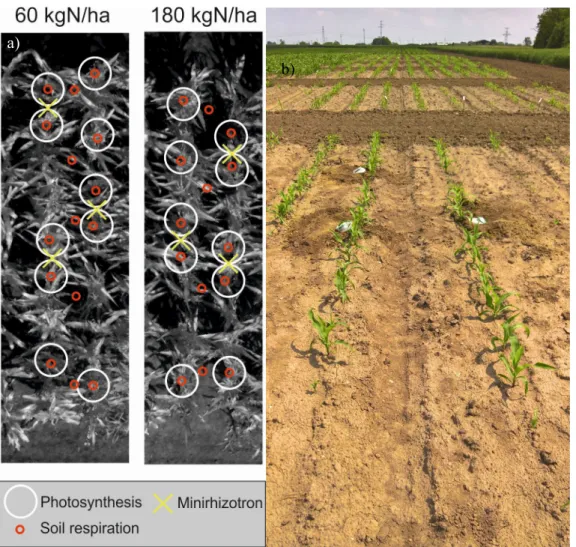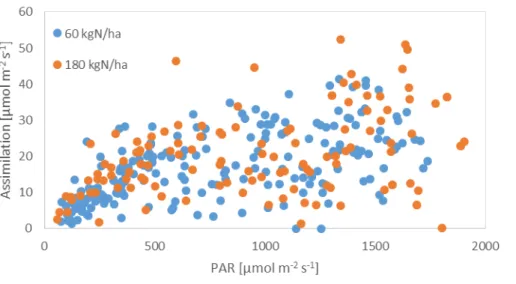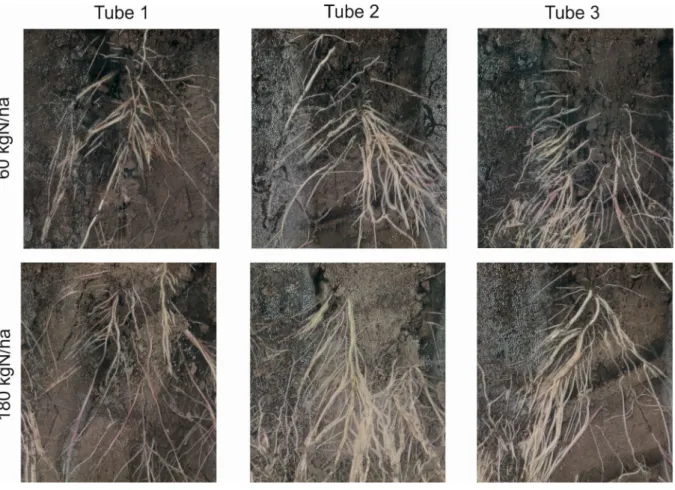MEASURING CO
2FLUXES IN MAIZE UNDER CONTRASTING NITROGEN FERTILIZATION TREATMENTS
Györgyi GELYBÓ1, Réka DELI2, Márton DENCSŐ1, Bernadett KÓSA2, Viktória MATEJKA2, Márton TÓTH3, Emese UJJ1, Tamás ÁRENDÁS4, Nándor FODOR4, Hosam BAYOUMI2
1 Department of Soil Physics and Water Management, Institute for Soil Science and Agricultural Chemistry, Centre for Agricultural Research/Herman Otto 15, Budapest, Hungary H-1022
2 Institute of Environmental Engineering, Óbuda University, Sándor Rejtő Faculty of Light Industry and Environmental Protection Engineering/Doberdó str. 6., Budapest, Hungary H-1034
3 Department of Soil Mapping and Environmental Informatics, Centre for Agricultural Research/Herman Otto 15, Budapest, Hungary H-1022
4 Crop Production Department, Agricultural Institute, Centre for Agricultural Research/Brunszvik 2, Martonvásár, Hungary
Abstract:
Carbon-dioxide (CO2) fluxes in the soil-plant-atmosphere system contain bidirectional material transport with organic and inorganic components, and various pathways. All are influenced by environmental and biotic conditions, from air temperature to plant development or soil microfauna.
Our aim by quantifying certain components of CO2 exchange between surface and the atmosphere, and observing the controlling factors is to develop a methodology for upscaling plot and leaf scale measurements to the canopy scale.
The site is a sowing time−fertilizer−maize variety field experiment near Martonvásár. We carried out simoultaneous observation of soil respiration (Rs) leaf scale photosynthesis (A), soil temperature and soil water content, root growth, and plant height under 80 kg N/ha and 160 kg N/ha fertilizer treatments.
Synchronized measurements were repeated in the vegetation period to detect relationship among them and to optimize the labour intensive protocol for this experimental setup. The results suggest that Rs correlated with air temperature measured by the gas analyser, and with soil temperature at 6-8 cm depth. In spite of the sometimes rapidly changing conditions during field measurements, A measurements showed reliable response to environmental factors.
Keywords:
CO2, soil respiration, maize
1. INTRODUCTION
There is a multi-purpose motivation behind our efforts to understand soil-plant-atmosphere carbon- dioxide and water fluxes in arable lands. Besides basic scientific curiosity, there are important economic, environmental and societal aspects. Under the undoubtedly changing climate [1], it is one of the main goals to decrease, to mitigate anthropogenic effect on chemical properties of the atmosphere, i.e. to reach or approach a GHG neutral agriculture (e.g. climate smart agriculture [2,3], while sustaining production. Carbon and water cycle in the soil-plant-atmosphere system influence yield, hence having important implications in food security.
Understanding agricultural systems is achieved by investigations on different scales and using wide variety of methods both in laboratory and field (e.g. [4,5,6]). Field measurements, information
obtained under realistic environmental conditions are the most important observations, which are able to reflect all the interactions present in the system. Characterizing these processes via the quantification of these physical parameters are challenging and sometimes expensive because of automatized instruments or extensive labour requirements.
Some of the relevant processes, especially those occurring in soils are slow [7], and long-term systematic effects are required to detect any changes [8]. Agricultural long-term experiments are excellent tools to investigate the effect of different management systems [9]. In these field experiments, a certain management option is applied systematically for decades so that the long term effect of such intervention might be detected. These experiments typically consist of many small treatment plots, where any destructive investigation method endanger the conclusions. In such situations it is of high importance to possibly avoid any destructive sampling. Non-destructive measurement methods have been drastically improved both in availability and reliability in recent years. On the other hand, small plot size constrain the selection of potential tools used in the investigation. Satellite observation are often not an option because of the resolution, ecosystem scale measurements of CO2 fluxes such as the eddy-covariance technique are again improper due to spatial representativity. Small scale measurements provide the only viable option in monitoring such experiments.
We carried out measurements in a long term agricultural field experiment at Martonvásár. The small plot size allowed us to apply good spatial representation of the treatment plots, while the applied non- destructive methods left vegetation and soil undisturbed. Besides investigation of CO2 fluxes in different treatment plots, we also focused on methodological problems in the synchronized measurements. We present here the preliminary results obtained from measurements in 2019 vegetation season.
2. EXPERIMENTAL 2.1 Site description
We selected a long-term field experiment for the measurements. The experiment is a sowing date- fertilizer-maize variety multifactorial continuous maize experiment [10]. We focused all activities to one variety (Mv Tarján) one sowing date (the last one, beginning of May) combined with two contrasting fertilizer treatments, 60 kgN/ha and 180 kgN/ha. Each treatment consists of two rows of maize with 70 cm row spacing.
We observed soil CO2 efflux (Rs), leaf scale photosynthesis (A), plant height, and root growth.
Measurement locations remained constant throughout the repeated measurements in the vegetation season. We started measurements on June 11 and repeated eight consecutive times in different phases of plant growth until 7th October. Of course, as maize ripened and stopped assimilation we terminated photosynthesis measurements. All measurements were performed in the morning hours between 9-12 AM.
We synchronized below and above ground measurements both in spatial and temporal sense. Plants next to root monitoring locations were selected for photosynthesis measurements with additional random maize plants. A total of five plants were monitored for leaf scale assimilation in each rows.
Soil respiration measurements were co-located with these plants. We present only averaged values
over the whole treatment and do not show detailed analysis of the co-located measurements. Fig 1.
shows the sites on aerial photo, taken at flowering (19 July) indicating measurement locations.
Figure 1. a) Aerial photograph of the study sites indicating photosynthesis (white circles), soil respiration (red circles) measurements and installed minirhizotron tubes (yellow X). b) Root tubes
installed in two rows of the 180 kgN/ha treatment.
2.2 Root development
The minirhizotron technique provided information to monitor root growth using CI-600 device (CID Bio-Science Inc, Camas, WA, USA). 1 m long root tubes were installed in the soil in an angle (aiming at 45 degrees) after sowing and emergence, on 7th June 2019. Root tubes are visible on Figure 1b right after installation in maize rows. Monitoring started on 1st July, approximately three weeks following installation to let roots grow around the tubes. The 1 m length of the tube allowed us to take 4 separate images of roots in the soil profile. Post-processing of the images and root detection was performed in the RootSnap! software (CID Bio-Science) specifically developed for the evaluation of minirhizotron pictures.
2.4 Photosynthesis measurements a)
b)
The CIRAS-3 portable photosynthesis system is capable of measuring leaf scale CO2 and H2O fluxes.
The measurements need cautious attitude and are time consuming, hence only a limited number of replications are possible if not automatized. We selected a total of ten plants per treatment, five in each row. Sampling was carried out from the bottom toward the top leaves five on leaves per plant. Besides concentration measurements of the gas analyser, the CIRAS-3 is equipped with environmental sensors, it records Photosynthetically Active Radiation and temperature during measurements, and provides several retrieved parameters relating CO2 and water fluxes. We took readings under ambient light and temperature conditions over a wide range of meteorological situations.
2.3 Soil respiration measurements
For the in-situ soil respiration measurements, we used the EGM-5 infrared gas analyser (PPSystems, Amesbury, MA USA) with the SRC-2 soil respiration chamber. As two major abiotic driver of soil CO2 efflux we observed soil temperature soil water content using a Hydrosense II Soil Moisture and Temperature Sensor (Campell Sci. Logan, UT USA). Ts and SWC was measured at 6-8 cm depth.
Location of soil respiration plots was synchronized with photosynthesis measurements. One plot was selected next to each plant, total of five plots per row. In addition to that we also selected five sampling plot in the inter-row space.
The gas analyser has built-in algorithms to calculate fluxes using linear and quadratic assumptions, which we both analysed, but only present data using the quadratic assumption.
3. RESULTS
Soil respiration showed considerable variation greatly both in time and space among the 15 sampling points and 8 measurement dates (Fig. 2). We present soil respiration values without considering to different treatments. On Fig. 2 all measurements are averaged over the sampling date regardless of treatment. Sample number was is typically 30 except some erroneous data that were removed from the dataset. Weather conditions were less variable as temperature records indicate (Fig. 2). There was only one rainy day, when soil respiration was also found to be increased.
Figure 2. Soil respiration (Rs) and its abiotic drivers: soil water content (SWC) and air temperature (Ta). Values show the average of all measurements in both treatments. Rs error bars represent ±
standard deviation.
Soil respiration was dependent on temperature (Fig. 3), we obtained non-linear relationship between Rs and both soil and air temperature based on the measurements. Temperature was quite high over the vegetation period, except for the last field visit when we experienced soil temperature around 10 °C.
The Rs rates at 10 °C to 15 °C range are lacking in the dataset, but Rs is increasing with temperature.
Figure 3. Soil respiration (Rs) and soil temperature (Ts) relationship. Measurement points show both fertilizer treatments.
The two flux calculation methods resulted in very similar Rs rates (1.13 µmol m-2 s-1 and 1.16 µmol m-2 s-1 for linear and quadratic assumption, respectively), with the quadratic assumption having slightly higher standard deviation.
Just like soil respiration, assimilation also varied with time and even from leaf to leaf. The rapid response of leaf scale photosynthetic rates to any changes in environmental circumstances influences successful measurements. Under field conditions, these external forces cannot be controlled hence these measurements need extra caution and patience on the field. Over the wide range of light conditions during our observations, we can examine the response of CO2 assimilation to incoming light. Due to the strong response to incoming light, the assimilation itself will not be indicative of differences among treatments. But the detected dependency shows the validity of the measurements under ambient conditions (Fig. 4).
Figure 4. Light response of assimilation in the two fertilizer treatments.
Assimilation varied vertically within the canopy, the lower leaves showing typically lower assimilation rates due to light availability. The CO2 assimilation at the uppermost leaves however, decreased again, in every single measurement occasion.
Plant height measurement was repeated on each plant in the two rows per treatment. Plant height at flowering (24 July) was higher in the low fertilizer dose (60 kg N/ha) treatment (189 cm versus 176 cm in the 180 kgN/ha plot), although the height of individual plants varied considerably (42 cm and 41 cm standard deviation in the 180 and 60 kg N/ha plots, respectively).
The experience using the root scanner showed that careful installation is required so that soil remains in contact with the tubes. The outer surface of the acrylic tubes is prone to condensation of evaporating soil moisture, which makes it difficult to automatically detect roots on the image. Fig. 5 shows the images in the uppermost level of the two treatments in all three replicates.
Figure 5. Root images taken on 11th July in the two fertilizer treatments. For tube locations see Fig. 1.
4. DISCUSSION
As a first step of the evaluation we checked the consistency and reliability of the retrieved data as compared to known physical relationships and previous results in the literature. Our results showed that in case of all measurements, data were in agreement with earlier results. The novelty of the approach as compared to our previous results is the complex measurement protocol focusing on below and aboveground parameters. Previous investigations of soil respiration was lacking detailed data of aboveground fluxes and plant development. [11] and [12] investigated soil respiration in a tillage experiment and found differences However, the complete understanding of soil-plant-atmosphere processes causing this difference in CO2 and H2O fluxes is very limited if plant processes are not considered. Management influences soil hydraulic properties [13] and hence water and indirectly CO2
fluxes. Water uptake by plants, plant transpiration governs soil moisture content, hence indirectly influence heterotrophic soil respiration and directly all autotrophic CO2 flux both above and belowground.
Preliminary results of the analysis of soil respiration data indicate that soil moisture was limiting factor especially in the beginning of measurement period (Fig. 2). This is contrasting with our previous results [11] where soil respiration was found to be mainly determined by temperature and not soil water content on the long-term in an arable land. This is probably due to methodological
differences in the spatial representation of the measurements rather than site characteristics e.g. soil type. In [11] automatized soil moisture measurements provided data on SWC at different depths, but without spatial replicates, which might influence the results obtained.
Different flux calculation methods are widely examined and used in the literature (e.g. [13]), the combined consideration of two calculation methods may provide additional information on the uncertainty of the measurements.
Minirhizotron images were found to be more reliable in clayey soils because soil (background) color homogeneity and contrast play a key role in success of root identification [14]. In our experience in soil with high clay content, the shrinking and swelling nature of clay soil complicates measurements by causing gap between the soil and the tube. In these gaps, condensation may occur, which is visible in Fig. 5 as well. We managed to take reliable images, but automatic root detection results are not reliable in this case when the images are affected by condensation. By processing the pictures we can obtain root length, diameter etc.
5. CONCLUSIONS
The aim of the present study was to explore components of the CO2 cycle in the soil-plant atmosphere system and to develop a viable and reliable protocol for synchronized measurements of different fluxes and related parameters. A main restriction of the idea is that all information should be retrieved under real field conditions with the least possible disturbance of plant and soil. We set up an experiment to optimize soil and plant measurements for tracking water and CO2 fluxes in agricultural systems in a non-destructive way.
The instruments we used allowed us to sustain a non-destructive measurement protocol in a sensitive long term field experiment with small plot size of maize. The ground measurements focused on soil CO2 efflux, non-destructive root system monitoring, leaf scale net assimilation measurements, with ancillary information on plant height, leaf area index, soil moisture and temperature. The observations also included proximal remote sensing efforts, which are not subject of the current study, but very well highlight the direction of passive or non-destructive sampling in the advanced monitoring of these small scale experiments.
The results showed that we could obtain reliable measurements with our non-destructive methods on CO2 fluxes in maize vegetation under field conditions in different weather situations. As a first step, an optimization of the measurement protocol for future measurements is available based on the present dataset. The detailed examination of co-located measurements will better reveal the connection between the measured parameters. This subsequent study may give us information on the factors and processes responsible for potential differences between contrasting treatments.
Acknowledgements. The research was supported by Bolyai János Fellowship and the Hungarian Research Fund. The research was supported by the Széchenyi 2020 program, by the European
Regional Development Fund ‘Investing in your future’ and by the Hungarian Government (GINOP-2.3.2-15-2016-00028).
REFERENCES References
[1] IPCC. In: Stocker TFQ, D. et al. CLIMATE CHANGE 2013: THE PHYSICAL SCIENCE BASIS.
CONTRIBUTION OF WORKING GROUP I TO THE FIFTH ASSESSMENT REPORT OF THE INTERGOVERNMENTAL PANEL ON CLIMATE CHANGE, CAMBRIDGE UNIVERSITY PRESS, CAMBRIDGE, UNITED KINGDOM AND NEW YORK, NY, USA, 2013, PP. 1535.
[2] FAO. CLIMATE-SMART AGRICULTURE - SOURCEBOOK, 2013.
[3] Lipper L, et al. CLIMATE-SMART AGRICULTURE FOR FOOD SECURITY. NATURE CLIMATE CHANGE, 4, 2014 1068.
[4] G Gelybó et al EFFECT OF SPATIAL HETEROGENEITY ON THE VALIDATION OF REMOTE SENSING BASED GPP ESTIMATIONS, AGRICULTURAL AND FOREST METEOROLOGY 174, 2013 PP. 43-53
[5] Reichstein M & Beer C. SOIL RESPIRATION ACROSS SCALES: THE IMPORTANCE OF A MODEL–DATA INTEGRATION FRAMEWORK FOR DATA INTERPRETATION, JOURNAL OF PLANT NUTRITION AND SOIL SCIENCE, 171. 2008, PP 344-354.
[6] Kern, A et al, STATISTICAL MODELLING OF CROP YIELD IN CENTRAL EUROPE USING CLIMATE DATA AND REMOTE SENSING VEGETATION INDICES, AGRICULTURAL AND FOREST METEOROLOGY 260-261 2018 PP. 300-320.
[7] Lal R. THE ROLE OF RESIDUES MANAGEMENT IN SUSTAINABLE AGRICULTURAL SYSTEMS. JOURNAL OF SUSTAINABLE AGRICULTURE, 5: 1995 PP 51-78.
[8] JOHNSTON A.E. & POULTON P.R. THE IMPORTANCE OF LONG-TERM EXPERIMENTS IN AGRICULTURE: THEIR MANAGEMENT TO ENSURE CONTINUED CROP PRODUCTION AND SOIL FERTILITY; THE ROTHAMSTED EXPERIENCE. EUROPEAN JOURNAL OF SOIL SCIENCE, 69, 2018 PP 113–125
[9] Katalin Debreczeni & Martin Körschens LONG-TERM FIELD EXPERIMENTS OF THE WORLD, ARCHIVES OF AGRONOMY AND SOIL SCIENCE, 49. 5, 2010, PP 465-483,
[10] Tóth E et al: SOIL CO2 EMISSIONS IN A LONG-TERM TILLAGE TREATMENT EXPERIMENT. IN: SOIL MANAGEMENT AND CLIMATE CHANGE. EFFECTS OF ORGANIC CARBON, NITROGEN DYNAMICS AND GREENHOUSE GAS EMISSIONS. ELSEVIER. ISBN 978-0-12-812128-3 (2018) PP 293-307.
[11] Gelybó Gy et al: FIVE YEARS OF SOIL RESPIRATION MEASUREMENTS IN TWO CONTRASTING TILLAGETREATMENTS OF A LONG-TERM FIELD EXPERIMENT GEOPHYSICAL RESEARCH ABSTRACTS, 21: EGU2019- 17285-1 (2019) EGU General Assembly 2019
[12] Horel Á et al. EFFECTS OF LAND USE AND MANAGEMENT ON SOIL HYDRAULIC PROPERTIES. OPEN GEOSCIENCES. 1, 2015. PP 742–754
[13] Kandel, T. P., Lærke, P. E., & Elsgaard, L. EFFECT OF CHAMBER ENCLOSURE TIME ON SOIL RESPIRATION FLUX: A COMPARISON OF LINEAR AND NON-LINEAR FLUX CALCULATION METHODS. ATMOSPHERIC ENVIRONMENT, 141 2016., PP 245–254.
[14] Munoz-Romero, V et al MINIRHIZOTRON IN: LAL R. ENCYCLOPEDIA OF SOIL SCIENCE CRC PRESS,. ISBN 1498738931, 9781498738934 2017 PP 1484-1488
Corresponding author:
Györgyi GELYBÓ
Department of Soil Physics and Water Management Centre for Agricultural Research
Herman Otto 15
H-1022, Budapest, Hungary
E-mail: gelybo.gyorgyi@agrar.mta.hu



